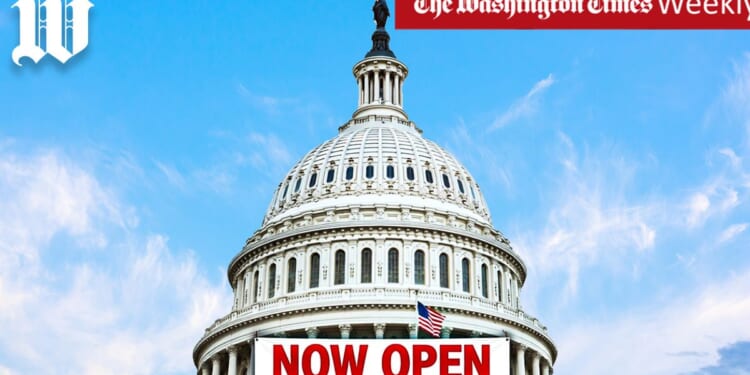
Hi, I’m George Gerbo and welcome to Washington Times Weekly, where we get a chance to sit down with our reporters and talk about their coverage of the latest news and events.
[GERBO] The longest shutdown in government history is finally at an end, and federal workers are headed back to work as Congress has finally passed, and President Trump has signed, a continuing resolution that will fund the government through the end of January. What exactly is in this funding package that finally Democrats and Republicans came to an agreement on?
[MCPHERSON] The shutdown is over; it took 43 days to end it. This package does not necessarily guarantee funding for the rest of the fiscal year for most of the government. A vast majority of it, nine of the 12 annual spending bills, are funded on a stopgap measure that runs through January 30th at the previous fiscal year levels. They did manage to include three full-year funding bills in this package that fund the legislative branch, which is basically Congress, the Department of Agriculture and the Department of Veterans Affairs. So there is some guaranteed certainty through the end of the fiscal year on September 30th for those agencies.
One big benefit that Democrats and Republicans pointed to is that it will fully fund the SNAP benefits, the food stamp program that was suspended this month. That was a big pain point in the shutdown and one thing that they wanted to avoid going forward. So that is one benefit. Democrats also did secure language in this package to require the Trump administration to recall the thousands of federal employees that were laid off during the shutdown. It also prevents the administration from enacting future reductions in force through January 30th at the end of that stopgap.
[GERBO] And for Democrats, they don’t yet have the chance to come to this signature issue that initially caused the shutdown, the extension of Affordable Care Act subsidies that they were saying millions of Americans are going to be off health insurance here, as the open enrollment period has just begun, and people start signing up for health insurance for next year. When is that vote coming, and how fractured is this caucus now, especially after you see eight Democrats end up voting with Republicans in the Senate to end debate on the bill and move forward with final passage?
And then even on the House side, six Democrats that voted for this final continuing resolution to go to the president. Where is their caucus now and when will they actually get to see a vote on these Obamacare subsidies?
[MCPHERSON] That was a big point of contention among Democrats as to whether to give in and end the shutdown without an extension of those subsidies. The eight Democrats who voted in the Senate to do so believed that Republicans were never going to agree to negotiate on the subsidies during the shutdown. They made that position clear, and that just dragging out further wouldn’t help them get to the end goal. They said this party strategy wasn’t working. Obviously, most Democrats didn’t agree with them, didn’t vote that way. But in doing so, they did secure a vote from Republicans, an offer that had been on the table since pretty early in the shutdown, about mid-October, so Republicans said they would give them a vote on a bill of their choosing to extend ACA subsidies. And that vote is scheduled for no later than the second week in December, according to Majority Leader John Thune. The question is how those negotiations unfold, whether it becomes a bipartisan product, if they can reach an agreement that can get 60 votes in the Senate, or if Democrats just put up their own bill that will ultimately fail if it doesn’t have Republican support.
[GERBO] And on the side of Republicans, Lindsey, there seems to be no winners in this shutdown, as in most cases there never are. Even Republicans getting docked in polling saying that Americans place some blame on them for the shutdown and for the inability to tame increasingly high costs on goods and services that are just being felt by Americans across the country. The House has been out for two months now since they took their vote in late September. They’re back in session now, but you know, as well as I do, you get to this time of the year and Thanksgiving’s coming up, Christmas and the holiday season coming up, and lawmakers are loath to stay in Washington to interrupt their time home in their districts and with families. And once we get to the new year, you’re already talking about primary election season for the 2026 midterms. So, what, realistically, is the path forward here for House Speaker Mike Johnson and his conference? What can they get done, if anything, before the end of the year, now that they are scrambling to make up lost time due to the shutdown?
[MCPHERSON] Well, certainly on the health care front, Mike Johnson is avoiding making any specific commitments the way that John Thune did. He’s not promising a vote. He is promising there will be an open debate and discussion of ideas on lowering health care costs. That does become difficult because of the time frame, as you said, between now and the end of the year. It’s difficult. Republicans don’t like the subsidies. They go directly to insurance companies in most cases. They think that, you know, pads the profits of these insurance companies, does not incentivize them to lower premium rates. And so they’re trying to explore ideas that would more broadly lower health care costs, maybe giving money directly to consumers in the form of health savings accounts or other ideas that are just floating out there. And a lot of this is going to be hard to negotiate in a short time frame. So realistically, I think it’s going to be tough for everyone to get to a compromise for sure. And then while they’re doing that, they also have to work on these full-year spending bills. The other nine that we talked about are running on a stopgap. It’s a lot to manage in a short amount of time, but they will be back to work a full week in the House next week, and they’re going to try to make up for some of that lost time. But it is going to be difficult, that’s for sure.
Watch the video to see the full conversation.





![Boomers Show Up In Force for the 'No Kings' Anti-Trump Protests [WATCH]](https://www.right2024.com/wp-content/uploads/2025/10/Boomers-Show-Up-In-Force-for-the-No-Kings-Anti-Trump-350x250.jpg)










